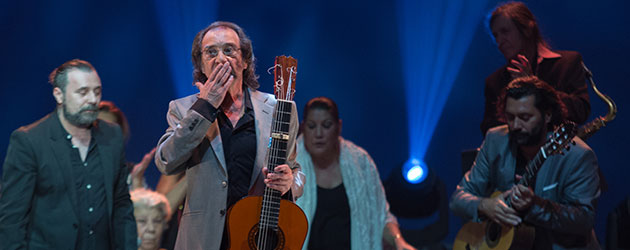José Manuel Gómez Gufi
Photos & video: Rafael Manjavacas
Pepe Habichuela. 60 years of flamenco guitar. Israel Galván, Miguel Poveda, Silvia Pérez Cruz, Familia Habichuela.
Actor Juan Diego petitioned the “Medalla del Trabajo” for Pepe Habichuela for a 60-year career with his guitar, and recalled how thirty years ago during a protracted tour with Enrique Morente, along with those young musicians who today are maestros, Pepe was the last one to go to bed, and the first to get up the following day. Teo Sánchez had taken note that the secret was in Amparo’s homecooked stews. And I think Pepe’s universality can be seen in that photo with Don Cherry that Mario Pacheco took at the Sala la Riviera (which at that time was called La Fiesta). Free jazz and flamenco looked at each other face to face, Pepe with his guitar, Don with that little trumpet that looked like a toy. They never played together in Madrid, but came together at the Zeleste club in Barcelona. The photo was hanging for years on the message-board of Nuevos Medios as symbol and example. Don Cherry had just made a record with Ed Blackwell called “El Corazón”, and old Pepe was deeply into that.
The third night began with Israel Galván, a dancer who represents for flamenco what Don Cherry was for jazz, a guy who does everything different and who, at times, is unintelligible. A cubist among neoclassical painters. After the solo, Pepe appeared from one side, and from the other, Miguel Poveda, the two made the singer’s first record together. The trio offered a contemporary repertoire with artists and collaborations in which, instead of accompanying the feet, they challenged each other with their hands and throats accumulating unresolved tension, because Galván disappeared with a jump. Silence.
Silvia Pérez Cruz came on, “I’m a lemon sherbet between two meat dishes”, and in that light vein she sang a song of hers that sounded like a Mexican ranchera of José Alfredo. Then, Javier Colina appeared, and they sang a Cuban song followed by “Tiene que Llover” from north-eastern Brazil with an imposing version of Luis Gonzaga’s, and ending with “Ruiseñores” along with the honored guitarist of the night.
Miguel Poveda returned, and did what he does with his group, passing through Cádiz to dance unashamedly, and he went on and on in every way, taking his time before saying he had the obligation to sing siguiriyas and all that, and doing it well, although he reminded us of Gregorio el Borrico. He could have stopped right there for an unconditional success, but went on singing as if it were one of his own recitals, which went against the spirit of the event.
Pepe Luis Carmona came on trying to reproduce the spirit of Morente, not an easy task. Jorge Pardo played the part of the Pied Piper, and brought the whole family together on stage. We all know these things can’t be rehearsed, but it felt like only the bean stew was missing. The important thing was the presence, the photo and the cake.
JAM AT THE BERLIN
The best was yet to come, and as we arrived at the Berlin, Pepe Habichuela arrived and sat in the front row so as not to miss Paquete with the singing of Kiki Cortiña. Juan Antonio Salazar appeared, leaving aside his whispered voice to sing full out…I liked him better before. Josemi came on, and the jam session reached full boil when Tomatito and his son, now more relaxed than in the Price theater, played some bulerías to send us home floating, or to not return in three days. Another incredible thing, and it was the be-all and end-all, it was Friday night and there was a long line for the discotheque. Let’s see if aunt Amparo will give us the recipe for her stew – after these three days we’re all ready for life support.
Videos:
